-->
While some of my participants flew from Cochabamba back to Santa
Cruz and then had flights homeward, three of us flew to La Paz in order to do
my brand new tour to three great birding areas of northern Bolivia. We met up with several participants arriving for just this tour, including Scott Marshall who brought me a battery charger for my camera. Back in business!
Our first birding was at lake Titicaca, where of course we hoped
to see Titicaca Grebe. Finding them wasn't a problem at all, and we really
enjoyed watching a family at close range.
This Plumbeous Rail was super cooperative.
Lake Titicaca was just a stopover point on our way to the Apolo
Valley, which involved two days of driving over a high Andean pass not far from
the Peruvian border. The birding and scenery were exhilarating, and we saw some
nice animals too, including these Vicuña, Vicugna
vicugna.
I was amazed to find this lizard under a rock. Closely related to
the one we had at Cerro Tunari, it can probably be identified by distribution
as Liolaemus signifer.
Also a cool find at these super high elevations was this frog Pleurodema marmoratum.
It’s a long, slow road, and we had a planned overnight in the town of
Charazani.
The next day involved dropping down through some nice patches of
cloud forest with some very nice birds, such as Amazonian Umbrellabird. This
terrestrial orchid on the roadside is Epistephium
duckei.
The road finally drops down into a broad bowl in the rainshadow of
the outermost ridges of the Andes, referred to as the Apolo Valley.
This isolated valley is home to a very isolated and very small
population of Swallow-tailed Cotinga. It’s different enough from the Brazilian
population to be considered by some a separate species, Palkachupa Cotinga.
This bird doesn’t have an official name at the moment, but it
should soon. We’re calling it the “San Pedro Tanager” after the town in Peru
along the Kosñipata Road where Dan Lane, Gary Rosenberg, and a WINGS tour first
spotted one almost 20 years ago. The use of specimen data to officially
describe the species has been tied up in stupid Peruvian and Bolivian red tape.
It was known from only a very few sightings of probable migrants in Peru until
just a few years ago when the core of its breeding range was discovered in the
uppermost reaches of the Tuichi Valley in Madidi National Park, downriver from
Apolo.
This migrant American Golden-Plover was fun to find in the Apolo
Valley.
The insects are barely studied in this area, and there are surely
some undescribed species. We all thought this cricket, probably a nymph, was
spectacular, but I don’t have a name for it yet.
This moth of the Dioptine subfamily of Notodontidae is Erbessa cingulina.
This satyr appears to be Godartiana
astronesthes, a new species described in a paper just 3 months earlier, and
known only from specimens in the Pampas del Heath just across the border in
Peru.
It took us two days to exit the Apolo Valley by road to return to
La Paz, but it was a short flight down to Rurrenabaque and then a late morning
drive to arrive at Sadiri Lodge, at the opposite end of Madidi National Park on
the outermost ridge of the Andean foothills. The lush forests here are full of
exciting biodiversity.
We had two local guides while here, the wonderful Raul Navi and
Ricardo Cuqui.
We saw almost all of the local specialties here, as well as more
widespread species such as this very confiding Common Scale-backed Antbird.
Raul pointed out this family of Great Potoos, which we would have
never seen without him.
It’s not typical to be able to identify beetles to species here,
but thanks to iNaturalist, this appears to be the weevil Marshallius multiguttatus.
And thanks to my passionflower contacts, I found this to be Passiflora cayaponioides, blooming one
day only right next to the main lodge building.
This small frog is Pristimantis
ventrimarmoratus.
Our final main destination on this itinerary was the exciting
Barba Azul Nature Reserve, which involved a longish drive to the small outpost
town of Santa Rosa de Yacuma and a chartered flight to the reserve out in the
middle of the Llanos de Moxos.
We arrived at Barba Azul at the end of the dry season, but some
recent rains had already begun flooding some of the very flat, extensive
grasslands.
We quickly found our primary target, Blue-throated Macaw, for
which this reserve was created and named. This is one of the rarest and most
endangered parrots in the world, and a large group gathers here in the
non-breeding season. We arrived just in time, while some were still around but
after the bulk had already dispersed north to breed.
The rich grasslands here have several specialties such as Black-masked
Finch.
Sharp-tailed Tyrant
Cock-tailed Tyrant
Long-winged Harrier being harassed by a Tropical Kingbird.
These grasslands are also an exciting place to search for mammals.
We were hoping to see Maned Wolf by the runway one evening, but an approaching
thunderstorm drove us back to the lodge buildings. We did see two Six-banded
Armadillos, Euphractus sexcinctus,
and I just barely managed to get a photo of one.
While we were birding the far eastern edge of the reserve, one of
the participants spotted this Giant Anteater, Myrmecophaga tridactyla, loping across the flats.
We finished the tour with a day of birding around Trinidad, where
we saw this enigmatic Gray-eyed Greenlet, a recently discovered disjunct
population, and possibly an undescribed taxon. It sounds like Gray-eyed Greenlet,
but notice that it has dark brown eyes.
Scarlet-headed Blackbird was on the power lines south of town.
Here’s our group, with guides and drivers, at Rurrenabaque. I look forward to doing this tour again in 2020.

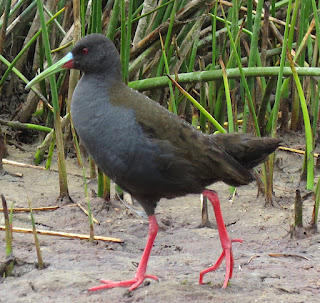










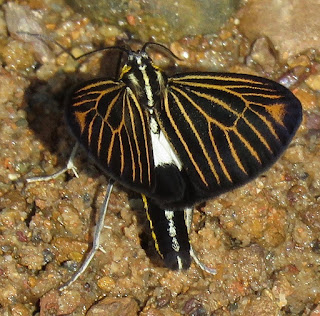


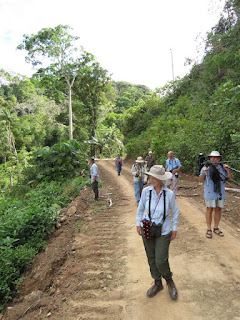



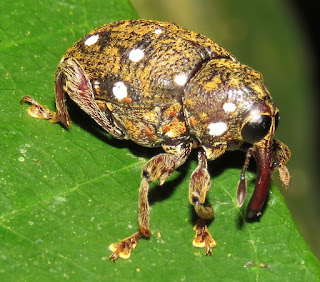

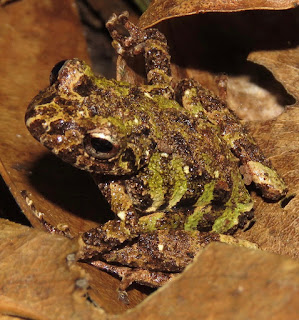



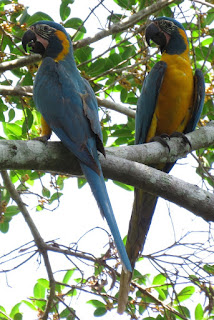





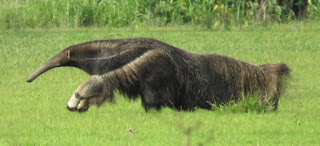








No comments:
Post a Comment